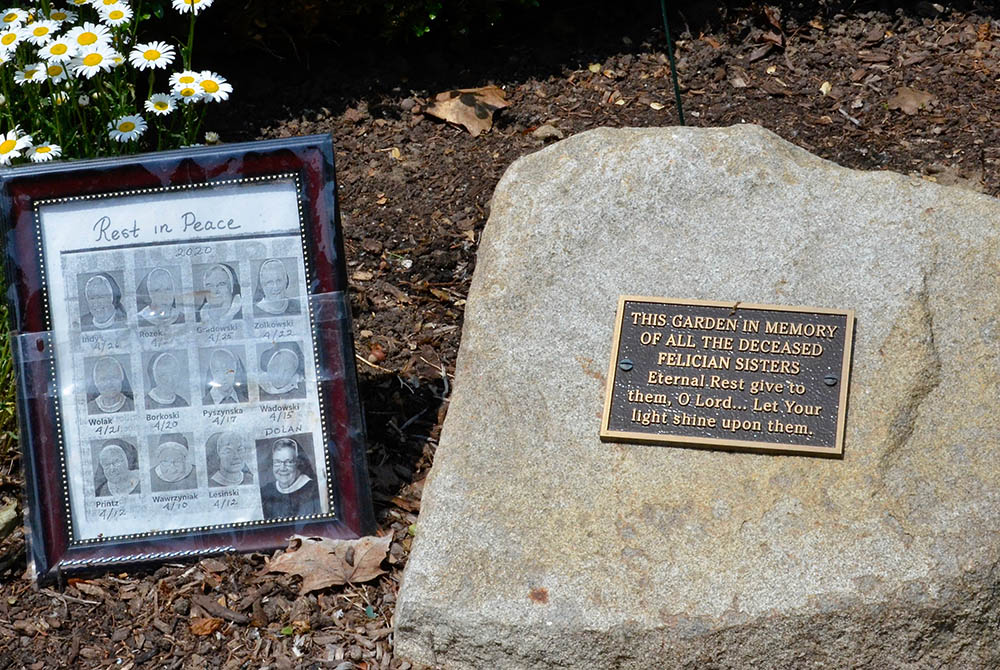
Felician Sr. Mary Ann Smith climbs a staircase in the Felician Sisters' convent in Livonia, Michigan, in June 2020 in this photo illustration. (GSR illustration/Dan Stockman)

(NCR, GSR logo/Toni-Ann Ortiz)
When the COVID-19 pandemic began a year ago, I read The Great Influenza: The Story of the Deadliest Pandemic in History by John M. Barry about the 1918 influenza pandemic.
The book tells how, when the number of infections exploded in Philadelphia, the first major city in the United States hit by the deadly flu, 2,000 nuns from all over the country came to nurse the sick. Hospitals were overwhelmed, so sisters set up clinics anywhere there was space. As a result, 23 of them died from their close contact with the infected.
It occurred to me that hundreds of women religious must have died in that terrible outbreak. There would have been deaths not just among those caring for the sick, but in convents across the country. After all, an estimated 50 million people died worldwide from what became known as "Spanish flu," and an estimated 675,000 of those deaths were in the United States.
But I could not find any organization that kept track of how many sisters died in that pandemic, let alone told their stories. Hundreds of sisters killed in the United States, and we have no comprehensive record of it beyond those 23. It is an incalculable loss made incomprehensible as it is lost to history.
As I was reading and pondering this in March 2020, convents were going into lockdown, trying to keep sisters safe from the virus that has ravaged their age group. Visitors were barred, travel was canceled, events were postponed.
But it wasn't enough.
The most insidious part of the COVID-19 virus, of course, is its long incubation period: One can be infected and infect others for up to 14 days before having any symptoms. Some apparently healthy people were, in fact, contagious, and the virus worked its way into convents, retirement homes and assisted-living facilities, where it exploded among the vulnerable population.
As sisters began to die, it quickly became clear that once again, no one was keeping comprehensive track of the religious we were losing. Their ministries, the people they touched, the mountains they moved: All of those stories are in danger of being lost.
I have tried to track them as best I can through Google Alerts and the reader tributes submitted to Global Sisters Report. At least once a week, it seems, there is another sister lost, and sometimes, there are horrible strings of them — a slow-motion story of pain and grief. Occasionally, there are shocking bursts of them all at once.
On April 9, 2020, there were reports that four sisters at the Our Lady of the Angels Convent in Greenfield, Wisconsin, a suburb of Milwaukee, had tested positive for the virus and another had died. Four days later came another death. Then a third, until eventually, six sisters had died at the convent, which specializes in memory care and is shared by the School Sisters of St. Francis and the School Sisters of Notre Dame.
Then came the awful news that four Maryknoll Sisters had died, then a Sister of Charity of Nazareth, a Sister of Mercy, and on and on and on, week after week, month after month.
Among them was Sr. Annelda Holtkamp of the School Sisters of St. Francis in Milwaukee, who was 102. She ministered for decades as a homemaker at convents in Illinois, Nebraska and Wisconsin, serving her fellow sisters until she retired at age 87.
Sr. Raquela Mesa-Acosta from Colombia died while ministering to the Hispanic community in Bridgeport, Connecticut. In her early years in the Congregation of Missionary Sisters of Mary Immaculate and St. Catherine of Siena, she served as a personal assistant to the order's founder, St. Laura Montoya.
Sr. Georgianna Glose, a Sister of St. Dominic of Amityville, New York, spent 51 years serving people kept poor in Brooklyn's Fort Greene neighborhood. She also helped sound the alarm on sexual abuse by priests within the Catholic Church. I met her in 2017 while working on a story about Sr. Sally Butler, with whom she lived, and she was outgoing, gregarious and passionate about her ministry.
Sr. Irene Loretta Cassady was beloved at the schools where she taught in Philadelphia. One student said she helped save his life when he was in a coma from a rare blood disorder: She held him in her arms while a priest said last rites. Another time, she insisted on visiting a student in the hospital even though she was in a wheelchair after a severe back injury. She died after nearly 70 years in the Sisters, Servants of the Immaculate Heart of Mary.
How many others, though, will we never even know about?
Advertisement
I suspect we all question life and death and God's plan and what it all means when there is a death close to us. But watching these reports come in week after week, the litany of lives ended too early, left me a little numb.
Then I saw the pain up close and in person.
The Congregation of the Sisters of St. Felix of Cantalice, or Felician Sisters, in Livonia, Michigan, lost 12 sisters from April 10 to May 10, 2020, and a 13th on June 27, 2020. Making the Felicians' anguish even worse: They could not observe their usual traditions when a sister dies. In fact, they largely couldn't leave their rooms at all, in an effort to stop the spread of the virus, and spent months in something like solitary confinement.
They were in shock. They had been through profound trauma and had almost no way to express it — until I reached out and asked whether they might be interested in telling their story to GSR. Once they were out of quarantine, I visited them, spending a day doing masked interviews conducted at least 10 feet apart. I was probably the first guest at the convent in months.
They had suffered such incalculable loss, but they wanted to tell their story. They wanted the world to know about these women, who had been teachers, a librarian, an organist, a nurse. They found some comfort in telling their story and even more comfort from the reaction: gifts, notes, love and condolences from around the world.

A small memorial to the 12 sisters who died in one month from COVID-19 sits in the gardens outside the Felician Sisters' convent in Livonia, Michigan. (GSR photo/Dan Stockman)
I had to enter their pain to write about it, but I took comfort that their story was told and that it brought them some measure of healing. You cannot share in someone's grief and not be changed.
The reports of sisters dying continued through the summer, fall and winter. And my efforts to track them are completely inadequate: The Google Alerts and reader tributes only find the late sisters that someone wrote a news story about or sent in to GSR. If there is only an obituary, the sister's death won't show up in a news search; a search of obituaries would miss any that do not include the words "COVID" or "coronavirus," which is most of them. My sifting of sister deaths overseas is even worse, as it only includes English-speaking countries or English-language coverage.
This poor accounting has found 95 sisters lost to COVID-19 in the United States, but the true number must be at least triple that. The deaths I know about outside the United States number only 155. I hate to even think about what the real number — and scope of the loss — is.
One community I talked to explained they have a standard practice when a sister dies: An obituary is published, and she is added to the list of deceased sisters on the website. They do that whether the sister was well-known with significant public achievements or whether she had a ministry of prayer. To issue a press release or allow a news story about only some sisters who died simply because of what caused their death wouldn't be right, they told me.
I understand that. But the greater church needs to know the extent of our loss. We have no full concept of what this pandemic has cost us. We cannot fully mourn these sisters if we don't know they're gone.
We're supposed to learn from history, yet we are repeating it. I can only imagine someone 100 years from now wondering what the toll was among those who dedicated their lives to serving God and his people and finding that no one counted them.
Perhaps this is a job for researchers rather than reporters, or each country's umbrella organizations for religious. I don't have the answers, only the questions that need to be asked.
This reaping is already tragic. We owe it to those who died to be able to tell future generations what we lost.







